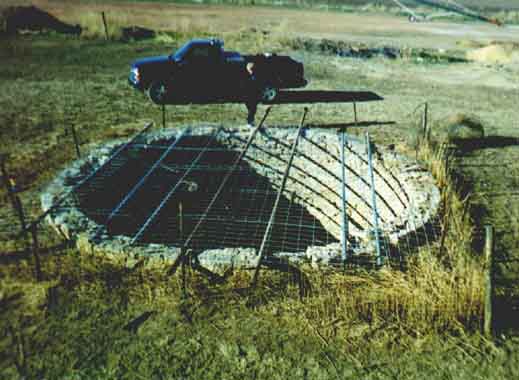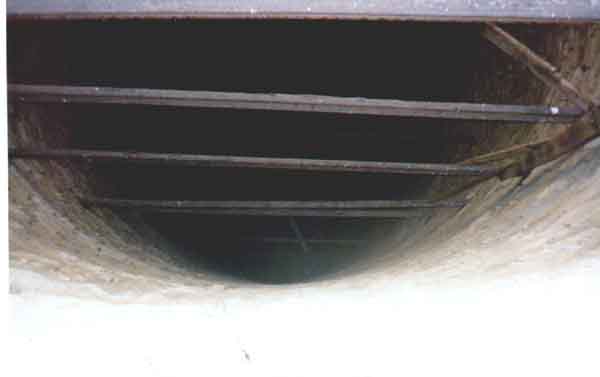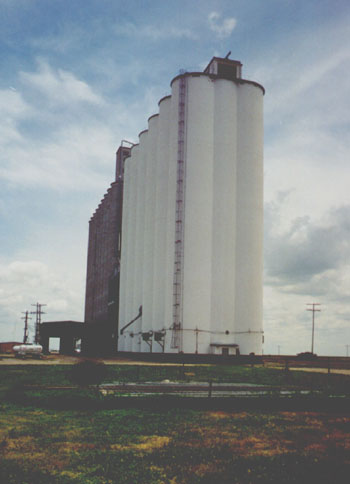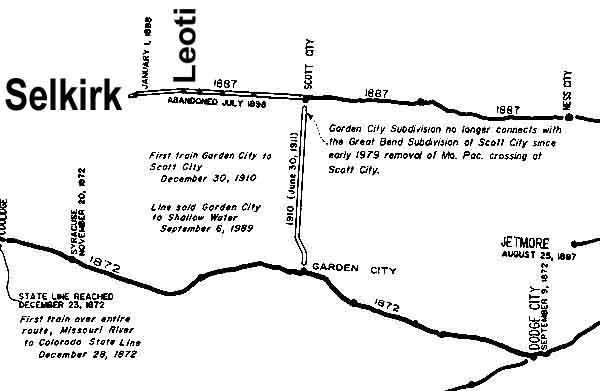
Here are the horses and men working the track at Coronado, which is 2½ miles East of Leoti. That is Arthur L. Walk sitting on the rail.
The town was bustling with excitement as the news was heard of the railroad coming through the newly formed town of Coronado, in Western Kansas. January 28, 1886 the first edition of the “Coronado Star” went to the press. New businesses were springing up fast! Soon the little country town had two hotels, a bank, several real estate and loan offices, a dry goods store, several hardware stores, a livery stable, two stage lines, a millenery shop, contractors and builders, and soon another newspaper started business called the “Coronado Herald”. More new businesses were arriving almost daily. Coronado was on the “Boom”! Now, there was the news of the railroad coming to Coronado, not just one, but two.

Soon, the depot, machine shops, pump house, well and water tank were all in place. The Coronado station was to be a division point. On July 28, 1887, the first steam locomotive arrived at Coronado. The D.M.&A. (Missouri Pacific) railroad was the first to finish their line. About one month later, the C. K. & W. (the Santa Fe) pulled in with their locomotive. People would board the train and ride over to the next county into Scott City to go to an afternoon baseball game. It became a social event to ride the train.
The railroads continued their race on to Leoti, which was just to be a stopping place to pick up passengers and freight at the depots. As they made it to each town, The Leoti Standard newspaper said, “there was great jolification and celebration”!
Next on the line was the little town of Selkirk, about ten (10) miles west of Leoti and one and one-fourth (1¼) miles east of the Wichita/Greeley county line. Again, the D.M.& A. made it to the town first, but the Santa Fe was close behind. The “Selkirk Graphic” newspaper of the late 1800's has given us much of the details of the events of the railroad in this little berg. It too, was expanding as the news was learned of the railroad going through town.

The track was completed September 15,1887 and the first regular train was run through to Selkirk on January 1, 1888. There was a large freight yard, the capacity at this point was not exceeded by any station on the line between here and Rush Center. It had switch room for twelve (12) cars more than at any point on the line. Selkirk having the capacity for seventy-one (71), while the next was Modoc with fifty-nine (59), while Leoti and Grigsby had fifty-eight (58).
The Santa Fe had built a large depot with ticket office, telegraph office, along with an ample waiting room, a freight house, machine shops, seven acres of stockyards with double- loading chutes, a large wooden water tower, pump house, and a hand-dug well.
This is where our story begins, as the old well is the only remnant of a once busy Santa Fe Railroad of the Great Bend Division in western Kansas. The hand-dug well has been beautifully preserved, being 110 years old. It is 24 feet in diameter and 102 feet deep, rock lined, and strange as it seems, they laid the rock from the top to bottom as they went down. It took forty-six (46) train car-loads of stone, nine (9) car-loads of lumber for the curbing, and five (5) car-loads of cement. There was 48,000 cubic feet of dirt removed from the well. This dirt was hauled on the train cars back to Ness City to be stock piled there, as dirt was a precious commodity. It was used for laying the railroad beds, etc. Out in western Kansas at that time, the buffalo grass grew like hair on a dog’s back. It was thick and rooted down as it grew along, making it almost matted. The settlers that came to farm had to use their teams and a special implement to dig up this buffalo grass. Many of them used this sod to build their homes and other buildings on their farmsteads. The only bare ground was where the farmers had plowed.
The water from this hand-dug well had many uses. First and foremost it was used for the steam for the engines, then also to supply water for the stationary boilers, wash train cars and floors, clean out the boilers, cooling ashes, fire protection, and many similar purposes at the shops, engine house, and the station buildings. The citizens of the town of Selkirk were also furnished water at the cost only of the fuel necessary to running the apparatus, which was as liberal as could be asked.

The tools for digging this well were very simple. A wooden frame was built over the well with pulleys attached with ropes. These ropes were tied on to half - barrels and were filled with the dirt down in the well. The ropes were attached to mules, oxen or workhorses on the outside of the well, that pulled the barrels up to be emptied. After the well was finished, the pump was placed in a pump house above ground which transferred the water into the large tank-tower for use as needed. There was a wooden staircase that went to just above the water level.

The Santa Fe line never went on to Denver as was originally planned, nor did it go to Colorado Springs, as was later planned -- it didn’t go any farther than Selkirk. It was not economically feasible to continues since it paralleled the D.M. & A. from Scott City. It was abandoned in May of 1896, and the rails were taken up in July of 1898. The steam engine is gone, and there is no use for the railroad wells now, most of them have been filled-in years ago.
This well has been kept covered and in the ownership of the same family for about seventy (70) years. It has been donated to the Wichita County Historical Society to be preserved. Our plans are to get it on the list of The State Register, along with the National Register of Historic Places. Our first project is to erect a building over the well, and make it an site for people to view and learn about the early railroad. We would also like to display railroad memorabilia of the Santa Fe Railway. Another of the exciting plans is to build a model railroad, with steam engines along with historic buildings of each town on this particular line. We hope that eventually we can build a replica of the wooden water tower that stood at that station site.

We, the Wichita County Historical Society, feel the strong need to save and protect this last vestige of the water-use of the 19th century railroad system in our county and perhaps the country!

E-mail the Wichita County Historical Society